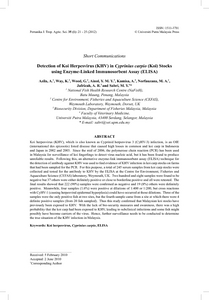Citation
Abdullah, Azila and Way, K. and G., Wood and Y. M. Y., Ainol and A., Kamisa and M. A., Norfauzana and A. R., Jafrizah and Mohd Yusoff, Sabri
(2012)
Detection of Koi herpesvirus (KHV) in Cyprinius carpio (Koi) stocks using enzyme-linked immunosorbent assay (ELISA).
Pertanika Journal of Tropical Agricultural Science, 35 (1).
pp. 21-25.
ISSN 1511-3701; ESSN: 2231-8542
Abstract
Koi herpesvirus (KHV), which is also known as Cyprinid herpesvirus 3 (CyHV-3) infection, is an OIE(international des epizootis) listed disease that caused high losses in common and koi carp in Indonesiaand Japan in 2002 and 2003. Since the mid of 2006, the polymerase chain reaction (PCR) has been usedin Malaysia for surveillance of koi fingerlings to detect virus nucleic acid, but it has been found to produceunreliable results. Following this, an alternative enzyme-link immunosorbent assay (ELISA) technique forthe detection of antibody against KHV was used to find evidence of KHV infection in koi carp stocks on farmsthat had been sampled for the PCR. For this purpose, a total of 245 serum samples from koi carp stocks werecollected and tested for the antibody to KHV by the ELISA at the Centre for Environment, Fisheries andAquaculture Science (CEFAS) laboratory, Weymouth, UK. Two hundred and eight samples were found to benegative but 37 others were either definitely positive or close to borderline positive and all were retested. Thefinal results showed that 222 (90%) samples were confirmed as negative and 19 (8%) others were definitelypositive. Meanwhile, four samples (1.6%) were positive at dilutions of 1:400 or 1:200, but cross reactionswith CyHV-1 (causing herpesviral epidermal hyperplasia) could have occurred at those dilutions. Three of thesamples were the only positive fish at two sites, but the fourth sample came from a site at which there were 4definite positive samples (from 20 fish sampled). Thus this study confirmed that Malaysian koi stocks havepreviously been exposed to KHV. With the lack of bio-security measures and awareness, there was a highprobability that the koi carp had been exposed to KHV, leading to subclinical infections and some fish mightpossibly have become carriers of the virus. Hence, further surveillance needs to be conducted to determinethe true situation of the KHV infection in Malaysia.
Download File
![[img]](http://psasir.upm.edu.my/4675/1.hassmallThumbnailVersion/Detection%20of%20Koi%20Herpesvirus%20%28KHV%29%20in%20Cyprinius%20carpio%20%28Koi%29%20Stocks%20using%20Enzyme-Linked%20Immunosorbent%20Assay%20%28ELISA%29.pdf)  Preview |
|
PDF
Detection of Koi Herpesvirus (KHV) in Cyprinius carpio (Koi) Stocks using Enzyme-Linked Immunosorbent Assay (ELISA).pdf
Download (1MB)
| Preview
|
|
Additional Metadata
Actions (login required)
 |
View Item |

